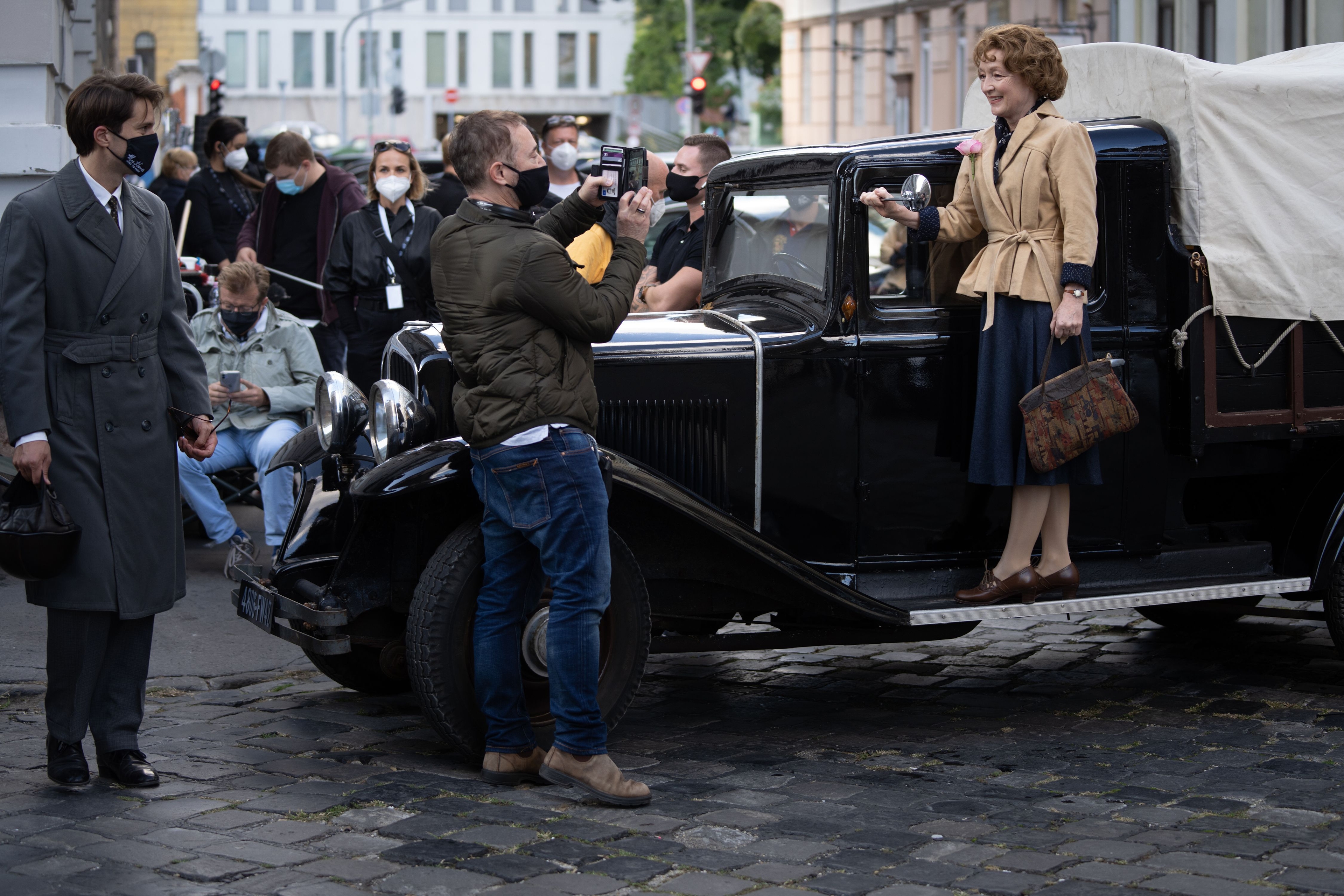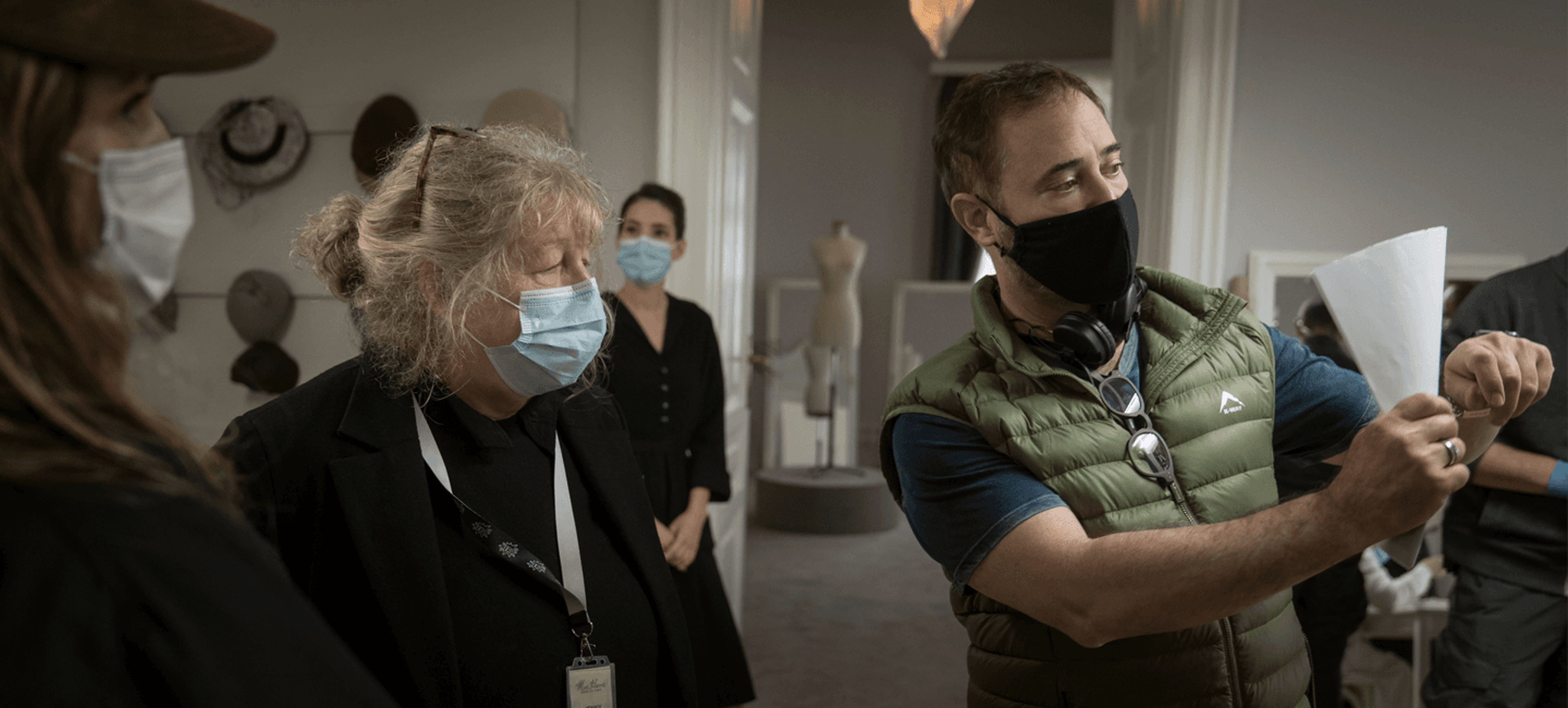When Mrs. Harris Goes To Paris hits movie theaters this summer, it won’t be the first time the character has ventured into our collective imaginations. Mrs Harris was first introduced to the public by Paul Gallico, who wrote the novel the film was based on in 1958. Mrs. Harris has since been seen in multiple books, a couple of TV movies, and even in a musical.
But why Mrs. Harris, and why now? Why does the story of a middle-aged charwoman living in post-war Britain strike as much of a chord now as it did almost 70 years ago? We sat down with Mrs. Harris Goes To Paris director Anthony Fabian to find out.
What specifically drew you to this project? How did you land on co-writing and directing a story from almost 70 years ago?
It's actually a bit of a mystery why one ends up being drawn to and obsessed by a particular movie in a particular subject. This came to me a bit gradually, in a way.
At one time, there was another producer who had developed a script and had the underlying rights. I thought, “well, it’s set in London in Paris, I grew up in Paris and London. So I think I know how to tell this story.” Also, the character of Ada Harris was so immediately charming and irresistible. It was hard to say no.
But that producer lost the rights to the book, so I decided to acquire them myself and start again with a new screenplay and a new set of collaborators. That was quite a lengthy process, because Gallico presents quite a few challenges, especially if you’re trying to adapt this book and make it not twee or clichéd. The more I got into the layers of the story and thought about how to bring depth and dimensionality to the story, the more engaged I became with it all.
In a lot of ways, this movie is about shooting for your dreams at any point in life, whether you're a 25 year old Dior model or a 55 year old charwoman. How did working on the movie remind you of that in your own life?
I think in a way, all of us have dreams. Things that are unattainable that we aspire to, and would love to either buy or achieve. Any filmmaker will be able to relate to this story, I think, because what we try to do as filmmakers appears to be completely unattainable. I mean, how are you going to get somebody to give you the resources to do something like this?
In a way, it’s never been a better time for filmmakers to start because they can make movies with their iPhone if they need to. But when I started, it was still the days of film. And it was expensive and difficult. My whole life has been striving for the unattainable dream of making a feature film released by Focus Features. And now here it is.
The first film that I made was a film called Skin, and the tagline was “Never give up.” People have often attributed that quality to me, because I am extremely persistent, but so is Ada in pursuit of her dress.

Fabian and Lesley Manville, who plays Ada Harris, together on set.
In 2022, we have the benefit of hindsight, so we know what a global powerhouse Dior would become, but in 1958, when the book was first written, was Christian Dior as mythical and grand a figure as he is now?
Interestingly, the reason the film absolutely had to be set in its original period is because Dior, as great as the brand is now, at the time, he was the king of fashion.
In that decade, he created the new look, which was an entirely different way of approaching dresses and dressmaking from what had come after the war, which was a very drab period when women's clothes were quite masculine and the dresses were short. After the austerity of the war, he created these designs that were opulent with tons of fabric, almost obscene amounts of expensive fabric. It completely caught everyone’s imagination, just as I hope that Mrs. Harris coming out after COVID will capture people's imagination because people want fantasy and they want escape. That's exactly what these dresses gave to people after the war.
Dior was never more famous or more popular. Then, he was kind of the single most important brand, in the ‘50s. Now, we have Chanel, we have Balenciaga, we have Alexander McQueen. We have a lot of competition in that space. I think it would be hard to argue that Dior is the summit of the fashion world today. It's amongst the top players, but certainly he was at the summit of the fashion world in the ‘50s, when the story is set.
Looking at that fashion show in the movie, that’s certainly evident, because every dress in there is famous and iconic. It’s like fashion history 101.
It's not in the book, but we decided that this is the 10th anniversary collection, because we wanted to show off his creations across that decade. And so we have iconic dresses that represent his output across those 10 years. There's a concentration and focus on 1957, which is when the film is set, but there are perhaps five or six dresses from earlier. Some of the hero dresses are also inspired by earlier dresses, like Miss Dior from 1950 is the first dress that she sees in Lady Dant’s bedroom. The dress called Venus is also inspired by an earlier dress. Temptation is based on a dress from ‘57. So we kind of played with his output across that decade. And I think that's why you get a sense of his entire oeuvre across that show.
You have done so much work with music and with musicians in your career. What direction did you want to go with music in the film and what were you listening to while you were writing and working on the movie?
I think my interest and relationship with music have influenced the making of this film a lot, but in a perhaps unexpected way, which is that I decided to approach this film as if it were a musical rather than a straight drama. It really affected my choice of the choreography of the camera, my choice of the color palette, and the costumes. And even, to some extent, there's a bit of an Alice In Wonderland feel to some of the sets. When you look at Lady Dant’s bedroom, it has these enormous tall doors and tall ceilings that are not quite human proportion. That all contributes to that sense of it being a heightened reality or a magic realism, which was inspired by musicals.
I looked at Funny Face and I looked at Umbrellas Of Cherbourg in particular. My Fair Lady, too, and even later films like Cabaret. Those were very much the influences that were part of the decision making in terms of how to make the film.
In terms of the music itself, I gave the composer a bit of a challenge. I said “I remember the days when you used to go out of the theater singing the theme tune from from a particular movie whether it was Zeffirelli’s Romeo And Juliet or The Godfather, both by Nino Rota.
You made this film during the pandemic and had to try and recapture a setting that, in some cases, just isn’t there anymore. A lot of London and Paris still does look very old, especially compared to the states, but it has to be a challenge to try and find a shot where there’s no skyscraper or cell phone tower or whatever. What were some of the challenges there?
We wanted to get as much of the budget on the screen as possible. The reality is that filming in London and Paris these days is not only complicated for the reasons you've said, because it's a period film and there are many modern elements that would need to be cleaned up through CGI, but also the cost. The producers, I think, very cleverly made the decision to make the principal shoot in Budapest, where it's much less expensive per day so you can spend more of your money on getting things right on screen.
I really worked meticulously with Luciana Arrighi, the production designer, and Jenny Beavan, the costume designer, of course. Also, the local Hungarian team. I was an absolute fascist about, “No, this isn't the right period. No, this isn't English. No, this isn't French,” because we were shooting in Budapest, and even though you might have the best crew in the world, they didn't always know what an English thing looked like, necessarily, or a French thing. Because I'd grown up in Paris and also in London, I was able to say, “This staircase could be in Paris. This staircase could be in London. This window is not English. This door is not French.” The challenge was how to make as much of Budapest as possible look convincingly like Paris or London.
We were lucky enough to be able to film some very key locations in the studio. We built the entire interior of Dior in the studio and we recreated it exactly according to the architectural plans that Dior had shared with us. It would have cost a fortune if we had done that in England or France, so that was a great help. Ada’s flat, interestingly, we also did in the studio. I’ve watched the film and I know that, and I'm still completely convinced that we're in a real place. That's the magic of cinema. For that, for example, Luciana chose William Morris wallpaper and details that were 100% authentically English.
The final crowning glory was that I always insisted we had to shoot some of the film in London and Paris to reinforce the authenticity. So for example, the Albert Bridge is the real Albert bridge, and the Wilton Crescent in Belgravia is really Belgravia. That pub in London where they spend some time at the beginning? That's a real pub on a real street in real London. There were things that you could never have found in Budapest.
Budapest was actually inspired by Paris, so there were many streets that looked like Paris and we were able to get away with quite a few exteriors in Budapest. But, again, with very clever use of CGI. For example, if you watch the movie, there was a flower market just like that in Paris, but it's not there anymore. So we found a space by a river that had a similar geography and configuration, and we map-painted the Notre Dame and other Paris buildings in the background.
On the other hand, when they're walking and talking by the Seine and the Pont Neuf, that's the real Pont Neuf. You say it was a challenge to do it during COVID, but it was also such an incredible stroke of luck that because of curfew and COVID, the bridges and the riversides were empty, so we didn't have to do crowd control. We actually had them all to ourselves.
